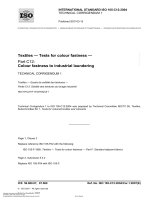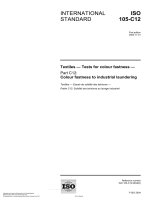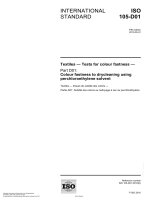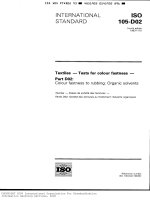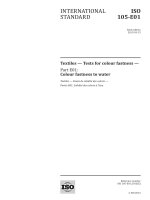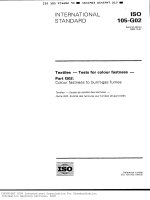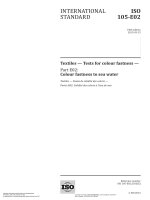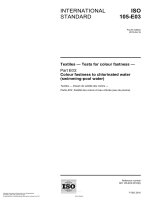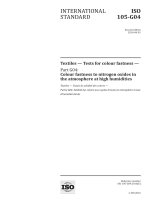Tiêu chuẩn iso 00105 c10 2006
Bạn đang xem bản rút gọn của tài liệu. Xem và tải ngay bản đầy đủ của tài liệu tại đây (131.34 KB, 12 trang )
INTERNATIONAL
STANDARD
ISO
105-C10
First edition
2006-06-15
Textiles — Tests for colour fastness —
Part C10:
Colour fastness to washing with soap
or soap and soda
Textiles — Essais de solidité des teintures —
Partie C10: Solidité des teintures au lavage au savon ou au savon et à
la soude
Reference number
ISO 105-C10:2006(E)
--`,,```,,,,````-`-`,,`,,`,`,,`---
Copyright International Organization for Standardization
Provided by IHS under license with ISO
No reproduction or networking permitted without license from IHS
© ISO 2006
Not for Resale
ISO 105-C10:2006(E)
PDF disclaimer
This PDF file may contain embedded typefaces. In accordance with Adobe's licensing policy, this file may be printed or viewed but
shall not be edited unless the typefaces which are embedded are licensed to and installed on the computer performing the editing. In
downloading this file, parties accept therein the responsibility of not infringing Adobe's licensing policy. The ISO Central Secretariat
accepts no liability in this area.
Details of the software products used to create this PDF file can be found in the General Info relative to the file; the PDF-creation
parameters were optimized for printing. Every care has been taken to ensure that the file is suitable for use by ISO member bodies. In
the unlikely event that a problem relating to it is found, please inform the Central Secretariat at the address given below.
© ISO 2006
All rights reserved. Unless otherwise specified, no part of this publication may be reproduced or utilized in any form or by any means,
electronic or mechanical, including photocopying and microfilm, without permission in writing from either ISO at the address below or
ISO's member body in the country of the requester.
ISO copyright office
Case postale 56 • CH-1211 Geneva 20
Tel. + 41 22 749 01 11
Fax + 41 22 749 09 47
Web www.iso.org
Published in Switzerland
ii
Copyright International Organization for Standardization
Provided by IHS under license with ISO
No reproduction or networking permitted without license from IHS
© ISO 2006 – All rights reserved
Not for Resale
--`,,```,,,,````-`-`,,`,,`,`,,`---
Adobe is a trademark of Adobe Systems Incorporated.
ISO 105-C10:2006(E)
Foreword
ISO (the International Organization for Standardization) is a worldwide federation of national standards bodies
(ISO member bodies). The work of preparing International Standards is normally carried out through ISO
technical committees. Each member body interested in a subject for which a technical committee has been
established has the right to be represented on that committee. International organizations, governmental and
non-governmental, in liaison with ISO, also take part in the work. ISO collaborates closely with the
International Electrotechnical Commission (IEC) on all matters of electrotechnical standardization.
International Standards are drafted in accordance with the rules given in the ISO/IEC Directives, Part 2.
The main task of technical committees is to prepare International Standards. Draft International Standards
adopted by the technical committees are circulated to the member bodies for voting. Publication as an
International Standard requires approval by at least 75 % of the member bodies casting a vote.
Attention is drawn to the possibility that some of the elements of this document may be the subject of patent
rights. ISO shall not be held responsible for identifying any or all such patent rights.
ISO 105-C10 was prepared by Technical Committee ISO/TC 38, Textiles, Subcommittee SC 1, Tests for
coloured textiles and colorants.
ISO 105 was previously published in thirteen “parts”, each designated by a letter (e.g. “Part A”), with
publication dates between 1978 and 1985. Each part contained a series of “sections”, each designated by the
respective part letter and by a two-digit serial number (e.g. “Section A02”). These sections are now being
republished as separate documents, themselves designated “parts”, but retaining their earlier alphanumeric
designations. A complete list of these parts is given in ISO 105-A01.
--`,,```,,,,````-`-`,,`,,`,`,,`---
This first edition of ISO 105-C10 cancels and replaces ISO 105-C01:1989, ISO 105-C02:1989,
ISO 105-C03:1989, ISO 105-C04:1989 and ISO 105-C05:1989, which have been technically revised.
iii
© ISO 2006 – All rights reserved
Copyright International Organization for Standardization
Provided by IHS under license with ISO
No reproduction or networking permitted without license from IHS
Not for Resale
ISO 105-C10:2006(E)
Introduction
The test methods in this part of ISO 105 are intended to reflect the effect of washing using soap or soap and
soda by domestic and commercial laundering procedures on the colour of textiles. The washes are carried out
in a similar manner to the ISO 105-C08 tests, but using soap.
The general principles of testing, described in ISO 105-A01, should be understood before using this part of
ISO 105.
--`,,```,,,,````-`-`,,`,,`,`,,`---
iv
Copyright International Organization for Standardization
Provided by IHS under license with ISO
No reproduction or networking permitted without license from IHS
© ISO 2006 – All rights reserved
Not for Resale
INTERNATIONAL STANDARD
ISO 105-C10:2006(E)
Textiles — Tests for colour fastness —
Part C10:
Colour fastness to washing with soap or soap and soda
1
Scope
This part of ISO 105 specifies five methods intended for determining the resistance of the colour of textiles of
all kinds and in all forms to washing procedures, from mild to severe, used for normal household articles.
This part of ISO 105 is designed to determine the effect of washing only on the colour fastness of the textile. It
is not intended to reflect the result of the comprehensive laundering procedure.
2
Normative references
The following referenced documents are indispensable for the application of this document. For dated
references, only the edition cited applies. For undated references, the latest edition of the referenced
document (including any amendments) applies.
ISO 105-A01, Textiles — Tests for colour fastness — Part A01: General principles of testing
ISO 105-A02, Textiles — Tests for colour fastness — Part A02: Grey scale for assessing change in colour
ISO 105-A03, Textiles — Tests for colour fastness — Part A03: Grey scale for assessing staining
ISO 105-A04 Textiles — Tests for colour fastness — Part A04: Method for the instrumental assessment of the
degree of staining of adjacent fabrics
ISO 105-A05, Textiles — Tests for colour fastness — Part A05: Instrumental assessment of change in colour
for determination of grey scale rating
ISO 105-F, Textiles — Tests for colour fastness — Part F: Standard adjacent fabrics
ISO 105-F01, Textiles — Tests for colour fastness — Part F01: Specification for wool adjacent fabric
ISO 105-F02, Textiles — Tests for colour fastness — Part F02: Specification for cotton and viscose adjacent
fabrics
ISO 105-F03, Textiles — Tests for colour fastness — Part F03: Specification for polyamide adjacent fabric
ISO 105-F04, Textiles — Tests for colour fastness — Part F04: Specification for polyester adjacent fabric
ISO 105-F05, Textiles — Tests for colour fastness — Part F05: Specification for acrylic adjacent fabric
ISO 105-F06, Textiles — Tests for colour fastness — Part F06: Specification for silk adjacent fabric
ISO 105-F07, Textiles — Tests for colour fastness — Part F07: Specification for secondary acetate adjacent
fabric
--`,,```,,,,````-`-`,,`,,`,`,,`---
© ISO 2006 – All rights reserved
Copyright International Organization for Standardization
Provided by IHS under license with ISO
No reproduction or networking permitted without license from IHS
Not for Resale
1
ISO 105-C10:2006(E)
ISO 105-F10, Textiles — Tests for colour fastness — Part F10: Specification for adjacent fabric: Multifibre
ISO 105-J01 Textiles — Tests for colour fastness — Part J01: General principles for measurement of surface
colour
ISO 105-J03, Textiles — Tests for colour fastness — Part J03: Calculation of colour differences
ISO 3696, Water for analytical laboratory use — Specification and test methods
3
Principle
A specimen of the textile in contact with one or two specified adjacent fabrics is mechanically agitated under
specified conditions of time and temperature in a soap, or soap and soda solution, then rinsed and dried. The
change in colour of the specimen and the staining of the adjacent fabric, or fabrics, are assessed with
reference to the original fabric, either with the grey scales or instrumentally.
4
Apparatus
4.1 Suitable mechanical laundering device, consisting of water bath containing a rotatable shaft which
supports, radially, stainless steel containers [(75 mm ± 5 mm diameter) × (125 mm ± 10 mm high)] of capacity
(550 ± 50) ml, the bottom of the containers being (45 ± 10) mm from the centre of the shaft.
The shaft/container assembly is rotated at a frequency of (40 ± 2) r/min. The temperature of the water bath is
thermostatically controlled to maintain the test solution at the prescribed temperature ± 2 °C.
Other mechanically devices may be used for this test, provided that the results are identical with those
obtained by the apparatus described in 4.1. Be aware of possible contamination (see the note in 7.2).
4.2
Balance, accurate to ± 0,01 g (see ISO 105-A01).
4.3 Mechanical stirrer, minimum 16,667 s−1 (1 000 r/min) to ensure thorough dispersion and prevent
settling.
4.4
Non-corrodible (stainless ) steel balls, approximately 6 mm in diameter.
4.5
Means of heating the soap solution, such as a hot plate.
5
Reagents and materials
5.1 Soap, containing not more than 5 % moisture and complying with the following requirements based
upon dry mass:
⎯
free alkali, calculated as Na2CO3: 0,3 % maximum;
⎯
free alkali, calculated as NaOH: 0,1 % maximum;
⎯
total fatty matter: 850 g/kg minimum;
⎯
titre of mixed fatty acids, prepared from soap: 30 °C maximum;
⎯
Iodine value: 50 maximum.
The soap shall be free from fluorescent brightening agents.
2
Copyright International Organization for Standardization
Provided by IHS under license with ISO
No reproduction or networking permitted without license from IHS
--`,,```,,,,````-`-`,,`,,`,`,,`---
© ISO 2006 – All rights reserved
Not for Resale
ISO 105-C10:2006(E)
5.2
Sodium carbonate, anhydrous (Na2CO3).
5.3 Soap solution, containing 5 g of soap (5.1) per litre of water (5.4) for test conditions A and B and 5 g of
soap (5.1) and 2 g of sodium carbonate (5.2) per litre of water (5.4), for test conditions C, D and E.
It is recommended to vigorously disperse the soap using a mixer (4.3) in grade 3 water at (25 ± 5) °C and stir
for (10 ± 1) min.
5.4
Grade 3 water, complying with ISO 3696.
5.5
Adjacent fabrics (see ISO 105-A01), either 5.5.1 or 5.5.2
Multifibre adjacent fabric, complying with ISO 105-F10, according to the temperature used:
--`,,```,,,,````-`-`,,`,,`,`,,`---
5.5.1
⎯
Type DW multifibre adjacent fabric containing wool and acetate (for tests at 40 °C and 50 °C and, in
certain cases, to be indicated in the test report, at 60 °C);
⎯
Type TV multifibre adjacent fabric not containing wool and acetate (in certain tests at 60 °C and in all
tests at 95 °C).
5.5.2 Two single-fibre adjacent fabrics, complying with the relevant clauses of ISO 105-F01 to
ISO 105-F07.
One of the adjacent fabrics shall be made of the same kind of the fibre as that of the textile to be tested or that
predominating in the case of blends. The second piece shall be made of the fibre as indicated in Table 1 or, in
the case of blends, of the kind of fibre second in order of predominance or as otherwise specified.
Table 1 — Pairs of adjacent fabrics
If first piece is
5.6
Second piece
For test at 40 °C and 50 °C
For test at 60 °C and 95 °C
Cotton
Wool
Viscose
Wool
Cotton
—
Silk
Cotton
—
Viscose
Wool
Cotton
Acetate
Viscose
Viscose
Polyamide
Wool or cotton
Cotton
Polyester
Wool or cotton
Cotton
Acrylic
Wool or cotton
Cotton
Non-dyeable fabric, if required (e.g. polypropylene).
5.7 Grey scales, for assessing change in colour and staining (ISO 105-A02; ISO 105-A03), or a
spectrophotometer for assessing change in colour and staining complying with ISO 105-J01, ISO 105-A04
and ISO 105-A05.
3
© ISO 2006 – All rights reserved
Copyright International Organization for Standardization
Provided by IHS under license with ISO
No reproduction or networking permitted without license from IHS
Not for Resale
ISO 105-C10:2006(E)
6
6.1
Test specimen
If the textile to be tested is fabric, either
a)
attach a specimen 100 mm × 40 mm to a piece of the multifibre adjacent fabric (5.5.1), also
100 mm × 40 mm, by sewing along one of the shorter edges, with the multifibre adjacent fabric next to the
face side of the specimen, or
b)
attach a specimen 100 mm × 40 mm between the two single-fibre adjacent fabric (5.5.2), also
100 mm × 40 mm by sewing along one of the shorter edges.
6.2 Yarn may be knitted into fabric and tested in this form. Where yarns or loose fibres are to be tested,
take a mass of the yarn or loose fibres approximately equal to one-half of the combined mass of the adjacent
fabrics and either
a)
place it between a 100 mm × 40 mm piece of the multifibre fabric (5.5.1) and a piece of the non-dyeable
fabric (5.6) and sew them along all four sides (see ISO 105-A01), or
b)
place it between a 100 mm × 40 mm pieces of the two specified single-fibre fabrics (5.5.2) and sew them
along all four sides.
6.3 Determine the mass, in grams, of the composite specimen using the balance (4.2) to aid accurate liquor
ratio volumes.
7
7.1
Test procedures
Prepare the soap solution (5.3) according to the test used.
7.2 Place the composite specimen in the container together with the specified number of steel balls
(Table 2). Add the necessary amount of soap solution (5.3) preheated to the test temperature ± 2 °C,
according to Table 2, to give a liquor ratio of 50:1 ml/g. Close the container and operate the machine at the
temperature and for the time specified in Table 2. Begin timing as soon as the container is closed.
Test number
Temperature
°C
Time
Number of steel
balls
Sodium carbonate
A (1)
40
30 min
0
−
B (2)
50
45 min
0
−
C (3)
60
30 min
0
+
D (4)
95
30 min
10
+
E (5)
95
4h
10
+
Care should be taken to differentiate clearly between containers used for testing with and without fluorescent
brighteners.
NOTE
Containers (see 4.1) could be contaminated by the fluorescent brightening agents present in other test
detergents and in commercial detergents. This could affect the colour fastness ratings of test specimens if such
contaminated containers were subsequently used for tests using a detergent without fluorescent brighteners.
7.3 For all tests, remove the composite specimen at the end of the wash and place it in a 4 l beaker half
filled with grade 3 water (5.4) at ambient temperature. Gently agitate, rinse for 1 min and then place the
beaker under a cold running tap for 1 min.
4
Copyright International Organization for Standardization
Provided by IHS under license with ISO
No reproduction or networking permitted without license from IHS
© ISO 2006 – All rights reserved
Not for Resale
--`,,```,,,,````-`-`,,`,,`,`,,`---
Table 2 — Test conditions
ISO 105-C10:2006(E)
7.4 For all methods, extract the excess water from the composite specimen by squeezing the test specimen
by hand.
Open out the composite specimen by cutting the stitching except on one of the shorter sides if necessary.
7.5 Dry the specimen by pressing it flat between new filter papers to remove excess water. Then dry by
hanging it in air at a temperature not exceeding 60 °C, with the parts in contact only at the line of stitching.
7.6 Assess the change in colour of the specimen and the staining of the adjacent fabric with reference to
the original specimen using either the grey scales or instrumentally. See ISO 105-A02; ISO 105-A03;
ISO 105-A04; ISO 105-A05; ISO 105-J03.
8
Test report
The test report shall include the following information:
a) a reference to this part of ISO 105 (ISO 105-C10:2006);
b) all details necessary for complete identification of the sample tested;
c) the test conditions/test number used from Table 2;
d) the numerical grey scale rating and/or instrumental assessment for the change in colour of the specimen;
e) if single-fibre adjacent fabrics were used, the numerical rating for staining of each kind of adjacent fabric
used;
f)
if a multifibre adjacent fabric was used, the staining of each type of fibre in the multifibre adjacent fabric,
and the type of multifibre adjacent fabric used;
--`,,```,,,,````-`-`,,`,,`,`,,`---
g) any deviation, by agreement or otherwise, from the procedure specified.
© ISO 2006 – All rights reserved
Copyright International Organization for Standardization
Provided by IHS under license with ISO
No reproduction or networking permitted without license from IHS
Not for Resale
5
ISO 105-C10:2006(E)
Bibliography
ISO 105-C08, Textiles — Tests for colour fastness — Part C08: Colour fastness to domestic and
commercial laundering using a non-phosphate reference detergent incorporating a low temperature
bleach activator
--`,,```,,,,````-`-`,,`,,`,`,,`---
[1]
6
Copyright International Organization for Standardization
Provided by IHS under license with ISO
No reproduction or networking permitted without license from IHS
© ISO 2006 – All rights reserved
Not for Resale
--`,,```,,,,````-`-`,,`,,`,`,,`---
Copyright International Organization for Standardization
Provided by IHS under license with ISO
No reproduction or networking permitted without license from IHS
Not for Resale
ISO 105-C10:2006(E)
--`,,```,,,,````-`-`,,`,,`,`,,`---
ICS 59.080.01
Price based on 6 pages
© ISO 2006 – All rights reserved
Copyright International Organization for Standardization
Provided by IHS under license with ISO
No reproduction or networking permitted without license from IHS
Not for Resale
